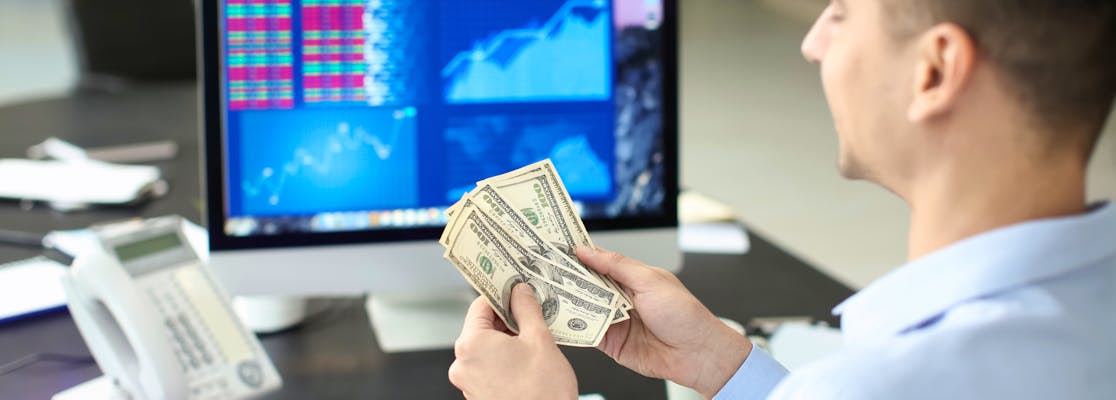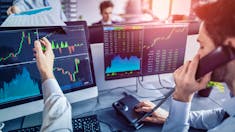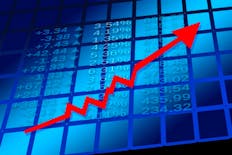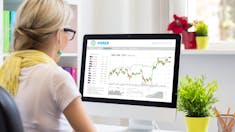Forex Automated Trading Strategies in 2025
All products and services featured are independently selected by WikiJob. When you register or purchase through links on this page, we may earn a commission.
When it comes to forex trading, passing control over to a forex automated trading system can be effective. Use of a robot removes the emotional element of trading and allows an individual to be absent whilst the system trades on their behalf.
Dedicated programs are capable of working out calculations at speeds no human could and can make tens of thousands of trades in a matter of seconds.
Automatic, or algorithmic, forex trading strategies refer to the different tactics and methods of trading an automated system can employ to generate the highest possible profits for the trader. In algorithmic trading, a specific trading strategy is translated into code and can be left to run without a human present.
Traders must decide on a strategy that will work best for them; there are many tried and tested rule-based automated strategies that are readily available from brokers or third party suppliers, but some individuals prefer to create their own.
If you aren’t proficient at coding, code can be produced by a third party or a specific program after you submit the required inputs.
Some strategies are easier to code than others; if you manually trade with a strategy which is very personal to you – subjective and not rule-based – it is likely to be extremely difficult to code.

Things to Consider When Deciding on a Strategy
- Your lifestyle – If you work full time you probably won’t want to risk employing a strategy which involves hundreds of trades being made during the working day. A certain level of monitoring is recommended when using an algorithmic system, so you may wish to go instead for less trade frequency over a longer period.
- Your finances – If you go for a high-frequency strategy, for example, you’ll find that commissions build up very quickly, so you need to have the capital there in the first place to fund your trading.
- Your personality – Are you able to let go? Algorithms don’t work well if they are continuously fiddled with. Whilst it’s important to keep an eye on things to make sure the market conditions haven’t changed so drastically that the algorithm won’t work, you must choose a strategy that you have confidence in – enough to leave well alone.
eToro is a multi-asset investment platform. The value of your investments may go up or down. Your capital is at risk.
Five Common Types of Trading Strategies
There are many different trading strategies available to purchase, here are five of the most popular:
1. News-Based
Inflation, war, political unrest, natural disasters, elections and bank talks, to name just a few, all have an impact on the world’s currencies.
A news-based trading strategy involves the algorithmic system reacting to news wires and generating trade signals based on what is happening in real-time.
Characteristically, this type of trading involves holding positions for a very short length of time – given the fast-paced media world where information is news one minute and forgotten the next.
2. Trend-Based
This is one of the most straightforward strategies and involves following market trends. A trend is where a price is moving in a certain direction (for example, up or down).
When the trend is going upwards, the automated system may take a long position – buying in anticipation of the stock, currency or commodity rising in value.
When there is a downward trend, the system is likely to go short, which means selling off the security to purchase it again later at a lower price.
Automated systems are capable of comparing current data with historical data to predict how likely it is that a trend will continue (rather than reverse).
3. Average Price/Mean Reversion
This strategy works on the understanding that historical returns and asset prices will at some point return to their average levels. This strategy attempts to capitalise on dramatic changes in the price of a security, with a view to it returning to its previous position.
This is a strategy that can be applied to buying and selling; traders can make a profit on surprise upswings and then save on anomalous lows.
It pays to remember that there are no guarantees in forex trading and that includes a return to a normal pattern. Uncharacteristic highs could return to a normal pattern, but equally, the high could be caused by certain events which throw things off-kilter long term.
4. High-Frequency (HFT)/Scalping
One of the most valuable aspects of using an automated system is its ability to operate at a pace no human could. High-frequency trading (or scalping) is the method of using an automated system to potentially make hundreds of thousands of trades in a fraction of a second.
The biggest criticism of HFT is that it allows the big players to dominate because they can trade in such substantial blocks (using algorithms). This type of trading adds liquidity to the market; however, many consider this a negative because the liquidity produced only lasts for seconds – too short a time for non-HFT traders to benefit from it.
A positive of HFT is that it removes small bid-ask spreads. A bid-ask spread or a bid-offer spread is the difference between the price at which an asset can be sold, versus the price at which the same asset can be bought. By widening the gap between, HFT traders can often exploit the system and make more money.
5. Arbitrage
‘Arbitrage’ is the term given to purchasing an asset in one market for a certain price and immediately selling it for a higher price in another market. This method relies on market inefficiencies; the trade is profiting through the exploitation of price differences on the same or very similar financial instruments across markets.
Arbitrage Trading Programs (ATP) use algorithms to identify price anomalies across different markets. Given how advanced technology has become, price anomalies don’t stay for long – they are picked up by traders with systems scanning for the same thing and then rectified. Therefore, ATP systems are the only way that these price differences can be taken advantage of – it is not something a human could do fast enough.
This strategy may seem fairly straightforward, but it should be noted that price differences in forex are usually minute. Therefore, traders using ATPs need to trade large positions to make a substantial profit.

How to Choose a Trading Strategy
So, which algorithmic trading strategy is best for you? A tried and tested off the shelf package? If so, which one? Perhaps a bespoke algorithm based on the way you have traded for years? If so, can you express that in code?
Here are some tips on how to choose a trading strategy:
Step 1. If It’s Not Your Strategy, Make Sure You Understand the Description
If you are looking to purchase a ready-made strategy, it is important to establish the key logic behind the strategy, and the description should leave you feeling well informed.
Pay close attention to buzz words like:
- ‘Profit target’ (the point at which the software will exit a trade)
- ‘Momentum’ (momentum can be used as a technique – acceleration can be identified and a long or short position can be taken in the hope the momentum will continue in a certain direction)
- ‘Stop-loss order’ (an automatic way to sell out of your position if the security falls to a particular price – a way of limiting loss on a position)
Also look out for details of range, breakout and trend.
Step 2. Check the Market Conditions the Strategy Is Designed to Operate With
Be wary of the market a certain strategy suits; the majority of strategies are only effective if matched with a particular market environment.
You should try to find a strategy that works effectively on the particular market you are targeting.
Step 3. Test Your Strategy Using a Demo Account
Backtesting is the process of testing a trading strategy on historical data. It is your route to identifying the profitability and performance of your strategy before you take the plunge and trade with real capital.
Backtesting can provide statistical feedback on averages, net profit/loss, annualised return, volatility measures, risk-adjusted return and more.
Step 4. Review Your Strategy in Terms of Won and Lost Trades
When evaluating the effectiveness of a strategy, it is easy to get caught up with individual trades.
Remember, this strategy is going to make thousands of trades so it is important to look at the wider picture, rather than focusing on the trades as individual details.
Review performance of the trades in groups of at least 10; look at the last 10 trades and whether or not the result added pips (exchange price movement between a currency pair) or took them away.
You shouldn’t go for a strategy which is not adding pips on this basis.
1. Pepperstone
Pepperstone offers extensive support for automated trading through its integration with various trading platforms and tools.
Both MT4 and MT5 support EAs, which are automated trading robots that can execute trades based on predefined strategies. Traders can either develop their own EAs using the MQL4 or MQL5 programming languages or download and use existing ones from the MetaTrader Market.
cTrader Automate (formerly cAlgo) allows traders to develop, backtest, and optimize automated trading strategies using the C# programming language. cTrader Automate provides a robust environment for coding custom indicators and trading robots.
Although primarily known for its charting capabilities, TradingView also supports automated trading through its Pine Script language, which allows traders to create custom indicators and strategies that can be automated. Integration with Pepperstone enables seamless execution of these strategies.
In some jurisdictions Pepperstone offers Signal Start, Copy Trading by Pepperstone for social trading, allowing traders to copy the trades of experienced traders directly into their accounts. This feature is beneficial for those who prefer automated trading but lack the time or expertise to develop their own strategies.
Pepperstone’s Smart Trader Tools include a suite of 28 additional tools for MT4 and MT5, which can enhance automated trading by providing advanced market analysis, trade execution, and risk management capabilities.
Pepperstone’s robust support for automated trading through platforms like MT4, MT5, and cTrader, combined with powerful tools like Autochartist and cTrader Automate, makes it an excellent choice for traders looking to leverage automated trading robots.
The ability to develop, test, and deploy custom EAs and the availability of advanced trading features and educational resources further enhance its appeal.
2. ForexVPS
ForexVPS is a company that provides servers specifically for trading. A Virtual Private Server (VPS) is on all the time, with no downtime – making it ideal for those who are running Expert Advisors on platforms like MT4 or 5.
To work correctly, an EA needs to be on all the time, so there are any problems with the internet connection or the terminal goes offline, you could lose opportunities and money.
Offering ultra-low latency, as little as 1 millisecond, with no sharing of resources and a 100% uptime guarantee. There are datacentres across the world that you can access through a Remote Desktop – you just need internet connection.
There are three pricing points for this service, and the only real difference is the amount of RAM and SSD that you get for your money. Starting from just £26.31 per month for 1 GB RAM, 1 CPU (Core), and 80 GB SSD, this is a service that can ensure the best performance of your robots and algorithms.
There is a way to get the mid-level package for free – through your broker. All you need to do is deposit at least the minimum and trade the monthly required volume – and there is no cost for your VPS. If you aren’t making the monthly volume, then you will only pay for the missing amount.
The ForexVPS also has a checker that you can use to test the latency of your broker.
3. IG
IG is a great share trading platform for beginners thanks to its user-friendly interface and extensive educational resources.
Pros of IG include a wide range of trading instruments and markets, as well as the ability to access multiple account types and trading platforms. The platform also offers a demo account for beginners to practise trading strategies before investing real money.
However, IG isn’t the cheapest share trading platform, with relatively high trading fees and a minimum deposit requirement of £250 when paying by credit/debit card or PayPal.
In terms of additional fees, IG charges a commission fee for share trading, starting from £8 per trade. There’s also a custody fee of 0.25% per year for holdings of £250 or more.
Overall, IG is a solid choice for beginners looking for a user-friendly platform with extensive educational resources, but investors should be aware of its fees and minimum deposit requirements.
An automated strategy means that decisions regarding buying, selling and other market actions are done without needing to be actively on the platform at the moment the decisions are made.
An individual will set their limits and the automated system makes decisions automatically.
In comparison, a manual strategy requires an individual to physically select whether to buy or sell.
There is no hard-and-fast way to work out how well an automated forex strategy will work or how long it will work.
One of the most important things to do when using an automated strategy is to continually monitor its effectiveness. This will enable you to see why quickly when it begins to lose its edge so that you can change strategies.
There are several options to choose from. One of the most popular choices for Forex robots is ForexVPS.
No. Automated trading is generally legal as long as it is regulated by a relevant body.
Yes, it can work. When carefully applied, automated trading strategies can help to minimize losses and may help to maximize profits.
You should always be aware that there is a risk involved with trading no matter how careful you are. There is always the chance that you will lose money.
There are five commonly recognized types of trading strategy and the effectiveness of them will vary depending on your situation, your needs and the amount of money you have available to finance your trades. The main forms of strategy are:
- News based
- Trend based
- Average price
- Scalping
- Arbitrage
The most commonly chosen form of forex trading for beginners is breakout trading.
If you are unsure of which strategy would be best for you, then there are several brokers that offer demo accounts. These will enable you to develop and test out different strategies without risking real money.
There is no one-size-fits-all answer to this question. The best strategy for you will largely depend on your needs and what you hope to achieve from your trades.
It will also be affected by how much money you have available to trade and the level of risk you are comfortable with.
Final Thoughts
The forex market has become increasingly popular given its ‘open all hours’ status (open 24 hours a day). What better way to make the most of a market which stays open longer than a person can comfortably trade, than enlisting the help of an automated system.
Choosing an algorithmic trading strategy can be difficult, but as long as you don’t deviate too heavily from how you would manually trade and you do vast amounts of homework to thoroughly understand what the algorithm is capable of, you’ll be on the right path to finding a strategy that works for you.
WikiJob does not provide tax, investment, or financial services and advice. The information is being presented without consideration of the investment objectives, risk tolerance, or financial circumstances of any specific investor and might not be suitable for all investors. Past performance is not indicative of future results. Investing involves risk including the possible loss of principal.





